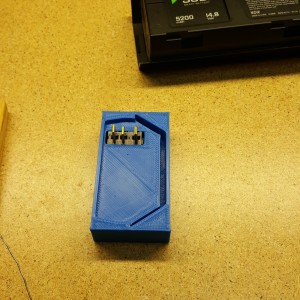Since most of my flying is closer to my car than a 120 V wall socket, I’ve built a 12V car charger for my Solo. My goal for this charger is to be able to charge at least one, possibly more batteries, without hearing the constant buzz that my power inverter makes.
I'm using one of these from amazon:
Amazon.com: DROK® 600W 12A DC Boost Voltage Converter 12-60V to 12-80V Step-up Power Supply Transformer Module Regulator Controller Constant Volt/Amp Car Regulated Laptop Battery Charger LED Driver Generator: Electronics
This is a variable output 12V DC-DC boost circuit with adjustments for max current and set voltage. The 600W in the description is misleading as it’s limited to 10 amps without a fan, so 10 amps at 60 V is 600W, but 10 amps at 12V is only 120W. Pay no attention to the review that says that you can’t adjust the current, they were wrong (or maybe I got lucky). The same circuit is available from several manufacturers, this is just the one I happened to pick.
I’ve cut my 3DR power supply cord and added an XT60 connector to it and to the DC power supply so I can move the plug from one to the other. Using a dummy load I’ve set the voltage at 16.8 V and the max current at 3.5 amps. I’ve plugged in a Solo battery to make sure it works--it does. In my minimal testing, it works great. At either 12 or 14.5 volts in, the power supply held its output steady at 16.80 volts. The heat sink barely got warm. And while I haven’t tested it for efficiency yet, I expect that it's about 85% or 90% efficient in this application (these circuits are more efficient when the in and out voltages are close to each other).
My question is this: What is the current limit that the “smart battery” circuitry charges at? I understand that the charger from 3DR is just a plain old 16.8 V, 3.3 amp wall-wart with nothing fancy going on, so the battery can’t charge itself with more than 3.3 amps with that charger. I also understand that it’s “smart” because it can control the rate a various charge levels of the battery. But it wouldn’t be very “smart” if it allowed me to throw 10 or 20 or 50 amps at the battery, so I would think that the battery has some sort of over-current protection.
I’d like to know if I set the power supply to 10 A to be able to charge multiple batteries at once, and there is only one battery connected, will that battery limit itself to say 1 C, or will it let itself take it all in?
I'm using one of these from amazon:
Amazon.com: DROK® 600W 12A DC Boost Voltage Converter 12-60V to 12-80V Step-up Power Supply Transformer Module Regulator Controller Constant Volt/Amp Car Regulated Laptop Battery Charger LED Driver Generator: Electronics
This is a variable output 12V DC-DC boost circuit with adjustments for max current and set voltage. The 600W in the description is misleading as it’s limited to 10 amps without a fan, so 10 amps at 60 V is 600W, but 10 amps at 12V is only 120W. Pay no attention to the review that says that you can’t adjust the current, they were wrong (or maybe I got lucky). The same circuit is available from several manufacturers, this is just the one I happened to pick.
I’ve cut my 3DR power supply cord and added an XT60 connector to it and to the DC power supply so I can move the plug from one to the other. Using a dummy load I’ve set the voltage at 16.8 V and the max current at 3.5 amps. I’ve plugged in a Solo battery to make sure it works--it does. In my minimal testing, it works great. At either 12 or 14.5 volts in, the power supply held its output steady at 16.80 volts. The heat sink barely got warm. And while I haven’t tested it for efficiency yet, I expect that it's about 85% or 90% efficient in this application (these circuits are more efficient when the in and out voltages are close to each other).
My question is this: What is the current limit that the “smart battery” circuitry charges at? I understand that the charger from 3DR is just a plain old 16.8 V, 3.3 amp wall-wart with nothing fancy going on, so the battery can’t charge itself with more than 3.3 amps with that charger. I also understand that it’s “smart” because it can control the rate a various charge levels of the battery. But it wouldn’t be very “smart” if it allowed me to throw 10 or 20 or 50 amps at the battery, so I would think that the battery has some sort of over-current protection.
I’d like to know if I set the power supply to 10 A to be able to charge multiple batteries at once, and there is only one battery connected, will that battery limit itself to say 1 C, or will it let itself take it all in?



